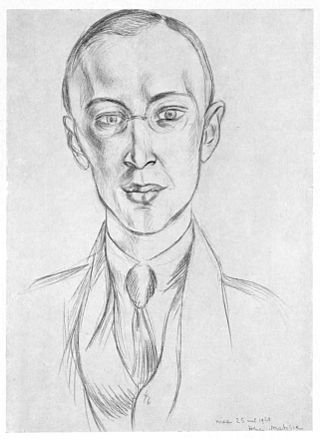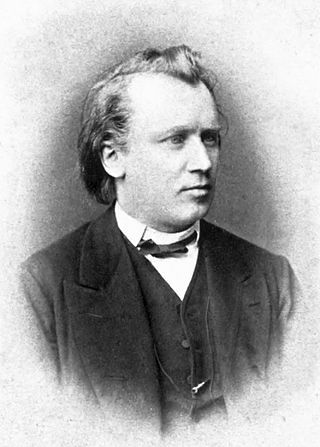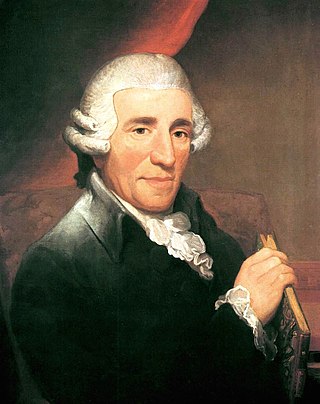Related Research Articles

The Symphony No. 1 in E minor, Op. 39, is a four-movement work for orchestra written from 1898 to 1899 by the Finnish composer Jean Sibelius.

Sergei Prokofiev wrote his Symphony No. 2 in D minor, Op. 40, in Paris in 1924-25, during what he called "nine months of frenzied toil". He characterized this symphony as a work of "iron and steel".

Sergei Prokofiev wrote his Symphony No. 3 in C minor, Op. 44, in 1928.

The Symphony No. 8 in G major, Op. 88, B. 163, is a symphony by Antonín Dvořák, composed in 1889 at Vysoká u Příbramě, Bohemia, on the occasion of his election to the Bohemian Academy of Science, Literature and Arts. Dvořák conducted the premiere in Prague on 2 February 1890. In contrast to other symphonies of both the composer and the period, the music is cheerful and optimistic. It was originally published as Symphony No. 4.

The Symphony No. 7 in C major, Op. 105, is a single-movement work for orchestra written from 1914 to 1924 by the Finnish composer Jean Sibelius.

Anton Bruckner's Symphony No. 7 in E major, WAB 107, is one of the composer's best-known symphonies. It was written between 1881 and 1883 and was revised in 1885. It is dedicated to Ludwig II of Bavaria. The premiere, given under Arthur Nikisch and the Gewandhaus Orchestra in the opera house at Leipzig on 30 December 1884, brought Bruckner the greatest success he had known in his life. The symphony is sometimes referred to as the "Lyric", though the appellation is not the composer's own, and is seldom used.

Anton Bruckner's Symphony No. 8 in C minor, WAB 108, is the last symphony the composer completed. It exists in two major versions of 1887 and 1890. It was premiered under conductor Hans Richter in 1892 at the Musikverein, Vienna. It is dedicated to the Emperor Franz Joseph I of Austria.

Symphony No. 2 in D major, Op. 73, was composed by Johannes Brahms in the summer of 1877, during a visit to Pörtschach am Wörthersee, a town in the Austrian province of Carinthia. Its composition was brief in comparison with the 21 years it took him to complete his First Symphony.

The Symphony No. 1 in C minor, Op. 68, is a symphony written by Johannes Brahms. Brahms spent at least fourteen years completing this work, whose sketches date from 1854. Brahms himself declared that the symphony, from sketches to finishing touches, took 21 years, from 1855 to 1876. The premiere of this symphony, conducted by the composer's friend Felix Otto Dessoff, occurred on 4 November 1876, in Karlsruhe, then in the Grand Duchy of Baden. A typical performance lasts between 45 and 50 minutes.

The Symphony No. 3 in C major, Op. 52, is a three-movement work for orchestra written from 1904 to 1907 by the Finnish composer Jean Sibelius.

The Symphony No. 70 in D major, Hoboken 1/70, was written by Joseph Haydn to mark the start of construction of a new opera house on the Eszterháza estate. It was premiered on December 18, 1779—one of the few Haydn symphonies where the exact premiere date is known.
Symphony No. 2 in A major is a classical composition by American composer Douglas Moore. It was composed in 1945 and received its premiere in Paris on May 5, 1946, conducted by Robert Lawrence. In the following year the American premiere was given in Los Angeles, Alfred Wallenstein conducting.
Michael Haydn's Symphony No. 29 in D minor, Opus 1 No. 3, Perger 20, Sherman 29, MH 393, written in Salzburg in 1784, is the only minor key symphony he wrote. It is the first of four D minor symphonies attributed to Joseph Haydn.
The Symphony No. 2 in E minor and C major by Arnold Bax was completed in 1926, after he had worked on it for two years. It was dedicated to Serge Koussevitzky, who conducted the first two performances of the work on 13 and 14 December 1929.
The Symphony No. 3 by Arnold Bax was completed in 1929. It was dedicated to Sir Henry Wood and is perhaps the most performed and most immediately approachable of Bax's symphonies.
The Symphony No. 4 by Arnold Bax was completed in 1930 and dedicated to Paul Corder. It was inspired by Bax's love of the sea and premiered in 1931 by British conductor Basil Cameron and the San Francisco Symphony Orchestra.
Ernest Chausson's Symphony in B-flat major, Op. 20, his only symphony, was written in 1890 and is often considered his masterpiece.
The Symphony No. 2 in B♭ major, D 125, is a symphony by Franz Schubert composed between 1814 and 1815. It is scored for 2 flutes, 2 oboes, 2 clarinets, 2 bassoons, 2 horns, 2 trumpets, timpani and strings.

Symphony No. 2, Ascensão (Ascension) is a composition by the Brazilian composer Heitor Villa-Lobos, written between 1917 and 1944.

The Symphony No. 1 in G minor by Russian composer Vasily Kalinnikov was written from 1894 to 1895 and first published in 1900. The symphony is dedicated to Russian music critic and teacher Semyon Kruglikov.
References
- 1 2 For publication and instrumentation see e.g. OCLC 929124298; also Promethean Editions Description of the 2015 Edition. All earlier publications listed in Worldcat are reproductions of the 1949 holograph; this publication is edited by Robert Hoskins (link is to his profile at NZSM.ac.nz.)
- Douglas Lilburn. The Three Symphonies. New Zealand Symphony Orchestra, James Judd, rec. 2001 on Naxos Records